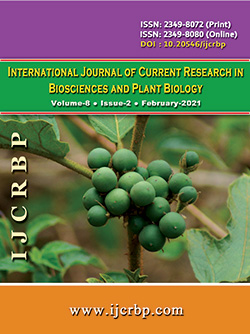 |
Online ISSN : 2349-8080 Issues : 12 per year Publisher : Excellent Publishers Email : editorinchiefijcrbp@gmail.com |
2Department of Biological Sciences, Faculty of Sciences, University of Bamenda, Bamenda, Cameroon, P.O Box 39 Bambili
3Department of Biological Sciences, Faculty of Sciences, University of Maroua, P.O Box 814 Maroua, Cameroon
The study was conducted in the Lebialem Highlands with the aim to assess the population distribution, sustainability and conservation status of Ternstroemia cameroonensis in its natural habitat. A total of 25 circular plots of 10 m diameter were established around T. cameroonensis and all species as well as threat to their sustainability evaluated. Data were collected, entered into excel and various percentages calculated while diameter at breast height of T. cameroonensis and three companion species where analysed in STATGRAPHICS XVII.II and the mean separated. The results revealed that T. cameroonensis is found in six localities, mostly between 1500 m to 2500 m above sea level. The three companion species were Aguaria saliciflora, Cyathea camerooniana and Draceana mannii. The most exploitable individuals were at Agocham (64%) while the least at Fossimondi (25%). The highest percentage of dead stems was recorded in Magha (42.85). Among the exploited stems, 33.33% showed a completely dead crown, whereas 10% regular and healthy. The main part of the species exploited w the bark (100%) and in case the stem gets dry it is exploited as fuel wood. T. cameroonensis was shown to be more vulnerable in Montane forests (2.8) than gallery forest (2.6).
